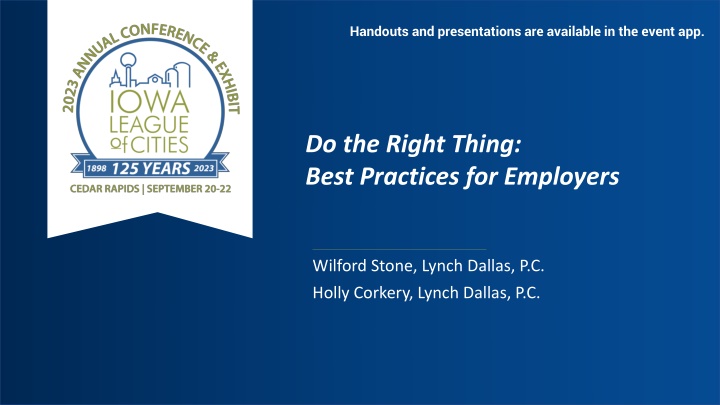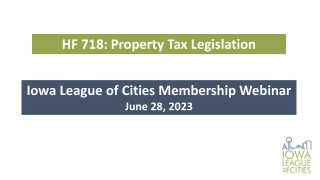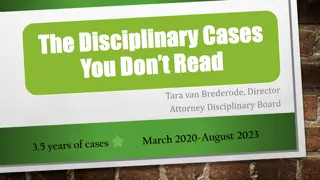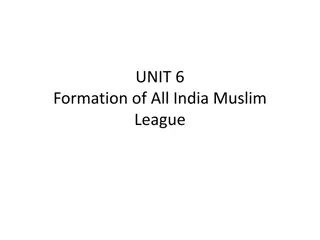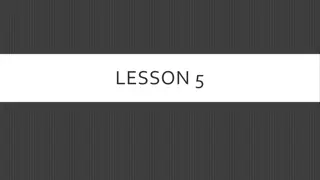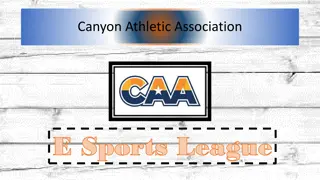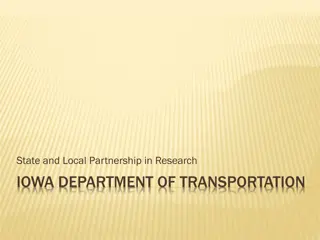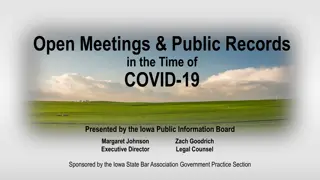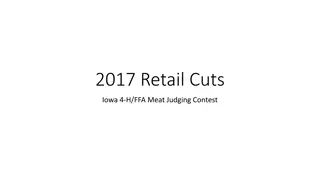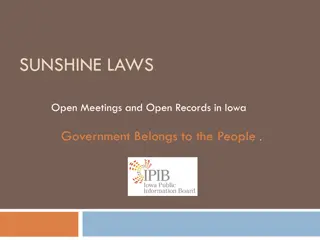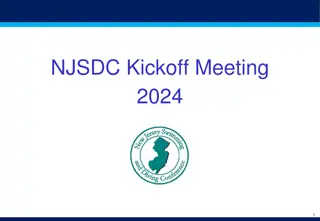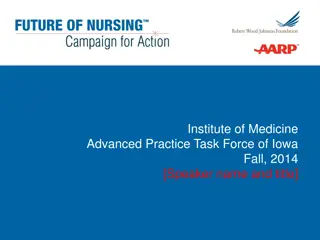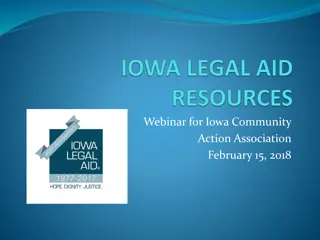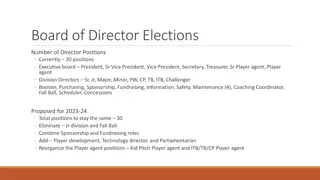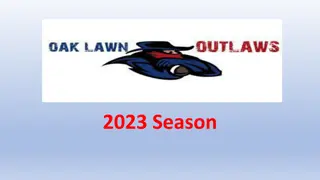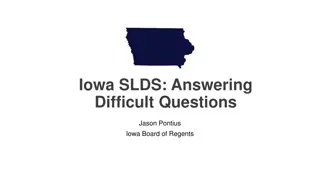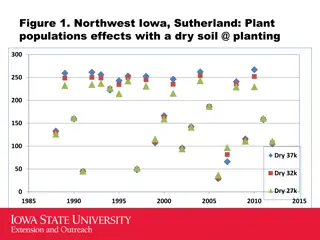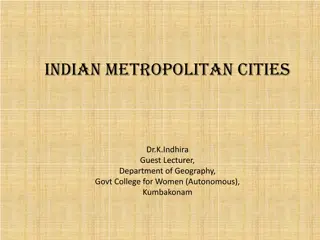Best Practices for Employers - Iowa League of Cities Annual Conference
Addressing discrimination, harassment, and workplace complaints is crucial for employers. Transparency in hiring processes, policies for employee leaves, and maintaining open communication are key components discussed in the event.
Download Presentation

Please find below an Image/Link to download the presentation.
The content on the website is provided AS IS for your information and personal use only. It may not be sold, licensed, or shared on other websites without obtaining consent from the author.If you encounter any issues during the download, it is possible that the publisher has removed the file from their server.
You are allowed to download the files provided on this website for personal or commercial use, subject to the condition that they are used lawfully. All files are the property of their respective owners.
The content on the website is provided AS IS for your information and personal use only. It may not be sold, licensed, or shared on other websites without obtaining consent from the author.
E N D
Presentation Transcript
Handouts and presentations are available in the event app. Do the Right Thing: Best Practices for Employers Wilford Stone, Lynch Dallas, P.C. Holly Corkery, Lynch Dallas, P.C.
Do the Right Thing: Best Practices for Employers Wilford Stone and Holly Corkery Iowa League of Cities Annual Conference September 21, 2023
Overview Next to doing the right thing, the most important thing is to let people know you are doing the right thing.
Overview Addressing known discrimination, harassment, retaliation and complaints in the workplace will remain crucial for employers. Discrimination: Occurs when a protected trait was a motivating factor for any employment practice, even though other factors also motivated the practice.
Hiring Process Is your application up to date? Be transparent with your workforce. Train your hiring team on do s and dont s.
Hiring Process Have policies and procedures in place now so applicants know what to expect. What do you need to get approved by Council? Moving stipends? Signing bonuses? Workplace flexibility? Benefits?
Workplace Issues Employee Leaves and Other Accommodations Pregnant Workers Fairness Act PUMP Act Americans with Disabilities Act/Iowa Civil Rights Act Family Medical Leave Act Workers Compensation
Workplace Issues When working through any of these laws, following policy, consistent application, and communication with employees are key. Corkrean v. Drake University (8th Cir. Dec. 2022): It is true that an employer s deviation from its policies can raise a material fact question on the issue of pretext. In Corkrean, deviation was slight and included an action plan to address employee s concerns so summary judgment for employer affirmed.
Workplace Issues General employee discontent/low morale. Open Communication. Consistent and Clear Expectations. Accountability. Get ahead of it. Be flexible.
Workplace Issues Pregnant Workers Fairness Act and Providing Urgent Maternal Protections for Nursing Mothers Act (December 2022) The PWFA requires employers with fifteen or more workers to grant temporary and reasonable accommodations for pregnant workers. Additionally, the PWFA prohibits employers from discriminating against a job candidate because of the need for pregnancy related accommodation(s).
Workplace Issues Pregnant Workers Fairness Act and Providing Urgent Maternal Protections for Nursing Mothers Act (December 2022) The need for the PWFA arose when prior statutory and case law did not guarantee accommodations for pregnant workers. Federal courts ruled that not granting reasonable accommodations for pregnant workers would only be discriminatory if the employer grants the accommodation for other workers, Pregnancy Discrimination Act of 1978, 92 Stat. 2076 (codified as amended at 42 U.S.C. 2000e et seq.)
Workplace Issues Pregnant Workers Fairness Act and Providing Urgent Maternal Protections for Nursing Mothers Act (December 2022) The PWFA requires reasonable accommodations for employees and applicants with known temporary limitations on their ability to perform essential functions of their job. The PWFA bars an employer from requiring an employee to take paid or unpaid leave if another reasonable accommodation can be provided.
Workplace Issues Pregnant Workers Fairness Act and Providing Urgent Maternal Protections for Nursing Mothers Act (December 2022) The Providing Urgent Maternal Protections PUMP Act expands the FLSA by providing break time to be considered hours worked if the employee is not completely relieved of their duties during the entirety of break. There is a small employer exception, but should discuss with legal counsel before applying exception.
Workplace Issues ADA-Related Trends Defines a person with a disability as a person who has a physical or mental impairment that substantially limits one or more major life activity, has a history or record of such impairment or is perceived by others as having such an impairment. Causes of action under the ADA can arise where an employer discriminates OR fails to accommodate a disability. Employee with a disability must be qualified to perform the essential functions of their job in order to be protected under ADA.
Workplace Issues ADA-Related Trends It is not necessary to provide a reasonable accommodation if doing so would cause an undue hardship. Undue hardship means that an accommodation would be unduly costly, extensive, substantial or disruptive, or would fundamentally alter the nature or operation of the business. Among the factors to be considered in determining whether an accommodation is an undue hardship are the cost of the accommodation, the employer's size, financial resources and the nature and structure of its operation.
Workplace Conduct Harassment: Complainant is a member of a protected class. Unwelcome harassment occurred. Causal nexus between the harassment and the protected- group status. Retaliation: Complainant engaged in protected activity. Employer took adverse employment action against Complainant. A causal connection between the conduct and the adverse employment action.
Workplace Conduct Retaliation in Violation of Public Policy: Requires the existence of a clearly defined and well-recognized public policy that protects the employee's activity. The public policy would be undermined by the employee's discharge from employment. The employee engaged in the protected activity, and this conduct was the reason the employer discharged the employee. The employer had no overriding business justification for the discharge.
Workplace Conduct Discrimination, Harassment, Retaliation Trends Sexual assault and harassment allegations against Rudy Guiliani. These allegations, whether true or not, provide us with a good reminder about appropriate conduct: The allegations include that Mr. Giuliani demanded that his employee work naked, in a bikini, or in short shorts with an American flag on them that he bought for her, that he regularly drank all day and night and was frequently under the influence of alcohol, and exposed himself to her. The allegations against Mr. Giuliani include that he made racist, antisemitic, homophobic and fatphobic remarks, as well.
Workplace Conduct Discrimination, Harassment, Retaliation Trends Things that may be considered insensitive or discriminatory: Comments about a co-worker s appearance. Making generalized statements about an ethnic group or race. Asking someone when they plan to retire. Using gendered language. Asking people about their religious beliefs. Speculating about someone s sex life. Use of drugs and/or alcohol in the work place or in a work-related setting.
Workplace Conduct Discrimination, Harassment, Retaliation Trends How do Employers defend against these claims? When a complaint is made OR when a supervisor otherwise becomes aware of discrimination, harassment, or retaliation take action. Are paid administrative leave or other remedial measures appropriate? Investigate and determine if complaint is substantiated. If complaint is substantiated, take prompt remedial action. If complaint is not substantiated, are there other issues that need to be addressed?
Workplace Conduct Discrimination, Harassment, Retaliation Trends How do Employers defend against these claims? Taking timely action on performance and misconduct issues with documentation. Conducting accurate annual performance reviews. Reviewing processes to ensure internal equity.
Workplace Conduct Discrimination, Harassment, Retaliation Trends How do Employers defend against these claims? Stansbury v. Sioux City Community School District (Iowa Ct. App. 2022). Where employer had documented disciplinary write ups, performance plans, and documentation of deteriorating performance, district had a legitimate business decision for a demotion/transfer.
Workplace Conduct Discrimination, Harassment, Retaliation Trends How do Employers defend against these claims? What about issues on social media?
Workplace Conduct Doing the Right Thing When Disciplining Employees: Ensure that you are following all due process and statutory requirements when disciplining: Is the right person disciplining? Is the employee a veteran? Is the employee in a Union? Was the employee appointed? Is the employee civil service? Does the employee have a contract? Is the employee in public safety? Provide the employee with due process, then make a decision. If terminating, ensure that all statutory requirements are met.
Workplace Conduct Doing the Right Thing When Disciplining Employees: If you must address discipline/terminations in a public meeting, ensure that the governing body is advised on what they can and cannot say.
Doing the Right Thing: Trends to Watch for in 2023 CROWN Act Created a Respectful and Open World for Natural Hair. Law prohibits race-based and national origin- based hair discrimination. Includes hairstyles such as locks, twists, braids, textures associated with race. Could become a federal law, not currently in Iowa. May update policies to include.
Doing the Right Thing: Trends to Watch for in 2023 Legislation re: Iowa Code Chapter 80f.1 and peace officer protections. Ensure you are current and following the laws related to these issues.
QUESTIONS? Lynch Dallas, P.C. Wilford H. Stone Holly A. Corkery wstone@lynchdallas.com hcorkery@lynchdallas.com www.lynchdallas.com Twitter: @lynchdallaslaw (319) 365-9101
